08
2024
-
11
Review: Application of Short Wave Infrared Silver Chalcogenide Quantum Dots in Optoelectronic Devices
Author:
Colloidal inorganic semiconductor quantum dots (QDs) have received significant attention in the fields of optoelectronic devices, photocatalysis and biomedical applications due to their excellent luminescence intensity, tunable emission wavelength, good optical stability and well-regulated surface electronic states. Among them, quantum dots emitting in the short-wave infrared region (SWIR,900-2500 nm) have attracted the attention of bioimaging and optoelectronics researchers. Due to its environmental friendliness and low solubility product constant, silver chalcogen (Ag₂ X,X = S,Se,Te) quantum dots emitting in the short-wave infrared have been widely studied. Especially in biological imaging, Ag₂ X quantum dots used as short-wave infrared fluorescent probes have made remarkable progress in promoting the early diagnosis, treatment and prognosis evaluation of diseases.
However, the current development of Ag₂ X quantum dot devices for optoelectronics lags far behind other short-wave infrared quantum dots, such as PbS. One of the most important factors is their low photoluminescence quantum yield (PLQY) which limits the efficiency of photoelectrode conversion. In silver-based quantum dot systems, common considerations include lattice defects due to the high mobility of monovalent silver ions, and surface defects caused by dangling bonds on the surface of the quantum dot, which trap a large number of excitons, resulting in non-radiative recombination and/or reducing effective electron and hole transport in the device. Therefore, the synthesis of short-wave infrared Ag₂ X quantum dots with high absolute PLQY has been very challenging for a long time, which especially hinders the application of Ag₂ X quantum dots in the field of optoelectronic devices. In recent years, researchers have focused on the development of high-quality short-wave infrared Ag₂ X quantum dots that exhibit high-efficiency photoluminescence (PL) emission. These developments have further stimulated intense research into their application in optoelectronic devices.
According to the Maims Consulting report, the Wang Qiangbin team of the Suzhou Institute of Nanotechnology and Nano-Bionics of the Chinese Academy of Sciences summarized effective strategies to inhibit non-radiative recombination of excitons to improve the PLQY of Ag₂ X quantum dots, and summarized their application in shortwave infrared optoelectronic devices And discussed the future opportunities of Ag₂ X quantum dots in optical property control and optoelectronic design. The review was published online in an internationally renowned academic journal entitled "Shortwave-Infrared Silver Chalcogenide Quantum Dots for Optoelectronic Devices".ACS Nano.
Synthesis of High PLQY Silver Chalcogenide Quantum Dots
The application of Ag₂ X quantum dots in biology and optoelectronics is based on their advanced physical and chemical properties (Figure 1). They have typical narrow band gaps and short-wave infrared absorption and fluorescence properties. Figure 1 illustrates the structural features of silver chalcogenide quantum dots and their optical properties in the short-wave infrared region.
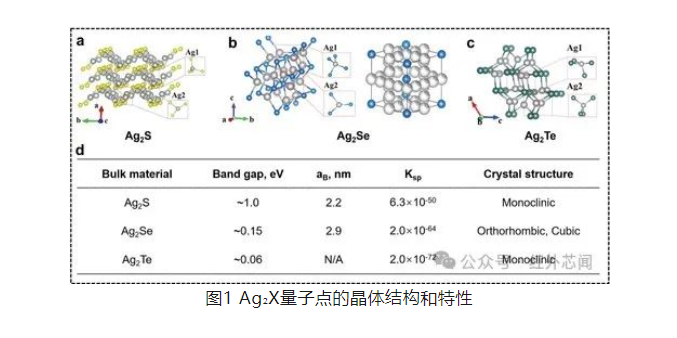
Heterogeneous metal ion doping is an effective method to improve the PLQY of Ag₂ X quantum dots. The incorporation of dopants into the quantum dots can tune the steric environment of Ag atoms and the electronic structure of the quantum dots to optimize their photoluminescence emission. Figure 2 shows the synthesis scheme of AgAuSe quantum dots and the absorption and photoluminescence spectra of Ag₂ Se and AgAuSe quantum dots, which can show the effect of improving the PLQY and luminous intensity of Ag-Se quantum dots by gold (Au) doping.
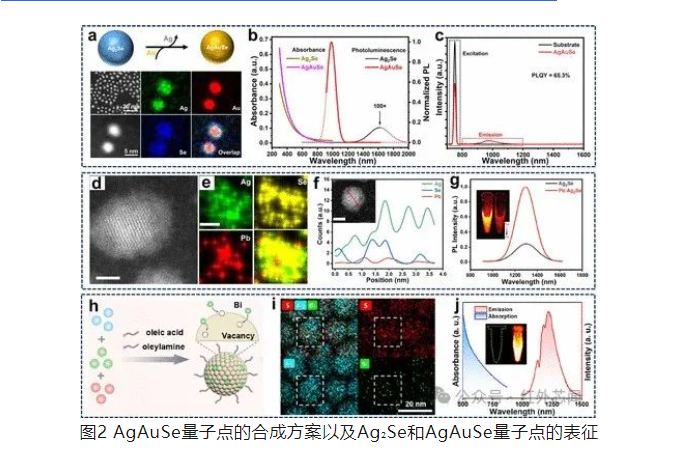
The presence of a defective state on the surface of a quantum dot greatly reduces its luminous efficiency. The unaligned surface atoms of quantum dots with dangling bonds can provide defect centers to trap excited electrons and holes, thereby hindering radiative recombination. To solve this problem, an effective strategy is to create a core-shell structure by introducing another inorganic semiconductor material with a matching lattice on the surface of the quantum dot. Another effective strategy is passivation. Chloride passivation is a common method used for surface passivation of Ag₂ X quantum dots. The relevant research results are shown in Figure 3, which proves the effectiveness of improving the PLQY and luminous intensity of Ag₂ S quantum dots through chloride passivation. Suitable surface ligands can also be designed with respect to the passivation strategy, which is an important component of colloidal quantum dots.
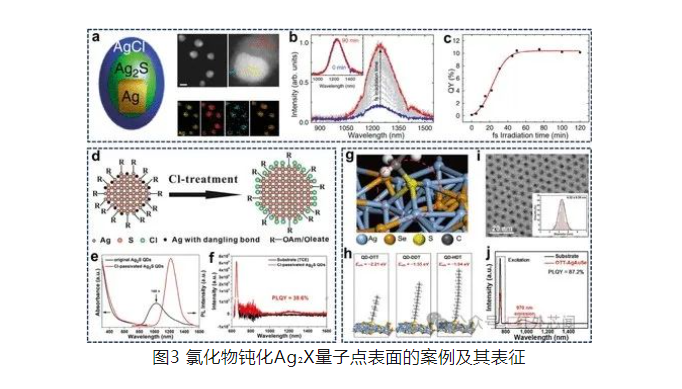
Research Progress of Silver Chalcogenide Quantum Dots in Optoelectronic Devices
Colloidal quantum dots are used in optoelectronic devices such as light emitting diodes (LEDs), photodetectors, and solar cells due to their numerous advantages such as high PLQY, wide absorption range, tunable absorption/emission, and solution processability. In recent years, based on the progress of synthesizing high-quality Ag₂ X quantum dots, their application in short-wave infrared electronics has been widely explored and has excellent performance. Figure 4 shows the performance of Ag₂ X quantum dots in LEDs and photodetectors.
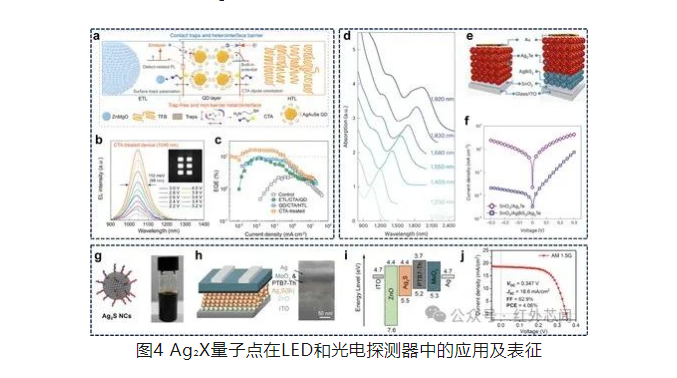
The methods of heteroatomic doping and surface passivation have achieved great success in enhancing the photoluminescence of Ag₂ X quantum dots, which promotes its application in high-efficiency optoelectronic devices. Although the optical properties and optoelectronic applications of Ag₂ X quantum dots have made great progress, there are still some problems that need to be solved in the future, as shown in Figure 5.
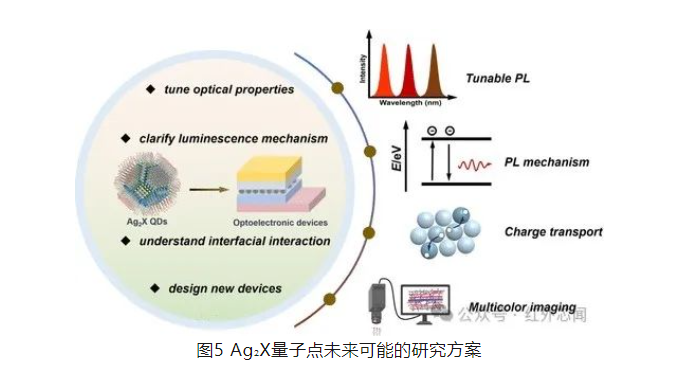
This research reviews the application and research progress of short-wave infrared Ag₂ X quantum dots in optoelectronic devices, and discusses in detail the strategies to improve the PLQY of these quantum dots, as well as their potential applications in high-efficiency optoelectronic devices. This is for the design and manufacture of advanced Optoelectronic devices provide new ideas.
LATEST NEWS
2024-10-05
Calculation of the diffracted light field: Regarding Fresnel near-field diffraction, how should the field distribution be calculated after a plane wave encounters a metasurface and experiences a phase jump?
Previously, a friend wanted to see the source code for the article 'Matlab Optical Fresnel Diffraction, Dynamic Visualization of Matlab Curves and Graphics', and the source code is included in this article.
2024-11-15
Academician Chang Ruihua's team has made new progress in short-distance optical communication high-speed interconnection technology.
850nm wavelength multimode vertical-cavity surface-emitting lasers (VCSELs) and multimode fibers (MMFs) have become the ideal choice for short-distance optical interconnects in data centers and supercomputing systems due to their low power consumption and cost-effectiveness.
2024-11-18
Wide spectrum heterojunction self-powered photodetector with linear and circular polarization detection capabilities
Two-dimensional (2D) materials have become a hot research topic due to their unique mechanical, optical and physical properties such as broadband response range, layer-dependent band gap, tunable electronic and optical properties, and high carrier mobility.
2024-11-07
Spin-based Schrodinger Cat States Prepared by Laser Cold Atom Method
The spin-based Schrodinger cat state is prepared by laser cold atom method, and its lifetime reaches the order of minutes, which helps to improve the measurement sensitivity of spin precession phase.

